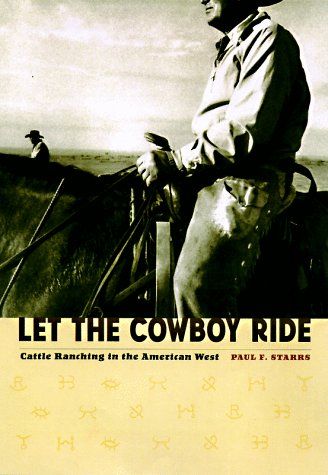Creating the North American Landscape
1 total work
The dime novel and dude ranch, the barbecue and rodeo, the suburban ranch house and the urban cowboy - all are a direct legacy of 19th-century cowboy life which still enlivens American popular culture. Yet at the same time, reports of environmental destruction or economic inefficiency have led to calls for restrictions in grazing livestock on public lands, or even an end to ranching altogether. In fact, writes Paul F. Starrs, the history of ranching in the United States is a full one of ongoing tension and conflict - between ranchers and farmers, between US citizens and their government, between Texas "cowboys" and California "buckaroos". In "Let the Cowboy Ride", Starrs offers a detailed and comprehensive look at one of America's most enduring institutions. Richly illustrated with more than 130 photographs and maps, the book combines the authentic detail of an insider's view (Starrs spent six years working cattle on the high desert Great Basin range) with a scholar's keen eye for objective analysis.
Tracing the geography and history of ranching in the US, Starrs tells how Anglo settlers first encountered the open grasslands of the West - an environment quite alien to most of the European experience. Knowing little of the West's unique geography, Congress in far-off Washington enacted land-use laws better suited to the needs of Jeffersonian yeoman farmers, with idealized 160-acre plots in the Ohio Valley, than to those of cattle ranchers in the semi-arid West. Starrs describes how these laws, which made it extremely difficult for citizens to obtain the large tracts of land needed for cattle raising, soon came into conflict not only with the stern realities of Western climate, but also with the customs and practices of the region's Hispanic inhabitants, whose system of land grants - based on group ownership of large tracts of land - was far better suited to ranchers' needs. Starrs tracks the imprint of these conflicts in shaping ranching today. He explores the paradox of the "lonesome cowboy", whose rugged individualism is in constant conflict with the need to accommodate federal land-use laws (resulting in a situation in which "the level of rancher unease ...is roughly proportional to the amount of rangeland controlled by the federal government").
And he shows how understanding past mistakes can shape land-use reform in the West today.
Tracing the geography and history of ranching in the US, Starrs tells how Anglo settlers first encountered the open grasslands of the West - an environment quite alien to most of the European experience. Knowing little of the West's unique geography, Congress in far-off Washington enacted land-use laws better suited to the needs of Jeffersonian yeoman farmers, with idealized 160-acre plots in the Ohio Valley, than to those of cattle ranchers in the semi-arid West. Starrs describes how these laws, which made it extremely difficult for citizens to obtain the large tracts of land needed for cattle raising, soon came into conflict not only with the stern realities of Western climate, but also with the customs and practices of the region's Hispanic inhabitants, whose system of land grants - based on group ownership of large tracts of land - was far better suited to ranchers' needs. Starrs tracks the imprint of these conflicts in shaping ranching today. He explores the paradox of the "lonesome cowboy", whose rugged individualism is in constant conflict with the need to accommodate federal land-use laws (resulting in a situation in which "the level of rancher unease ...is roughly proportional to the amount of rangeland controlled by the federal government").
And he shows how understanding past mistakes can shape land-use reform in the West today.
